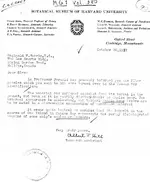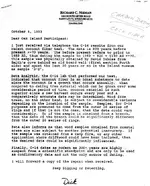I would like to hear (see) your two explanations as to how coconut fibres dated from before 1400 got to Oak Island!
Sure!
Theory #1: they simply washed up and were eventually covered up by sand. This theory doesn't explain a large amount of them, but to date no one has shown me any solid evidence that there was ever a large amount that needed explaining.
Theory #2: someone else could have carried those fibers there. There's little solid evidence that Templars ever went there. There's overwhelming evidence that Icelanders were in the area. They would have also had access to anything from the Middle East, as they did travel to and from Constantinople during that time period. (Google "varangian guard" if you're not familiar with the term.) I'm certainly not saying that this is what happened; I'm merely admitting that it's possible, and is in fact far more likely than anyone else based on available evidence.
In the first place we are not talking about only a treasure. During the first couple of decades of the existence of the order they were searching Jerusalem for religious artifacts. Catholics love religious artifacts and there are many of these alleged relics scattered throughout Europe.
I continually use the term "treasure" because it's applicable to all theories. By "treasure," I'm using the standard definition: "a quantity of precious metals, gems, or other valuable objects." Your religious artifacts (and money, and gems, and Shakespeare's screenplays, and UFO's, and anything else that someone thinks might be buried down there) are covered quite adequately by the word "treasure."
The Templars were being hunted in most European countries which at the time 1308 did not include Scotland, but they knew it was only a matter of time before it would be back under the authority of the Church so some decided they (mostly a group from the inner circle) would strike out for the Vinland of the Vikings. Many did chose to stay in Scotland though, some even blending into the Priory at Ardchattan. And there is the legend of some Templars helping Robert the Bruce defeat a British force at Bannockburn on June 24,1314.
A legend, yes. Oak Island seems to be overflowing with them.

I'll give you this, though: the idea that former Templars may have assisted Robert the Bruce is at least plausible, and isn't particularly easy to disprove.
As for Vinland though...why Vinland? What evidence is there that anyone decided this? Vinland was unsecure and teeming with hostile locals, at least according to the people that had been there. Iceland and Greenland were both extremely isolated, not subject to the whims of any king, easier to get to, and were largely populated by people that didn't even know what Templars were, let alone were on the lookout for them. They were far safer bets.
Sure, it was probably a risky voyage, but the Templars had latitude measuring devices, something the Vikings could only guess at. As a matter of fact, it was probably because of a lack of the ability to accurately determine latitude that the Vikings discovered the Canadian coast in the first place....Loki
Not at all. Have you read any of the sagas? There are numerous descriptions of how ships lost their way, and why. The big problem that they had was their sail design. They were quite innovative for the time, but their tacking performance by modern standards was awful. The result was that if the wind and currents weren't going where they wanted to go...well, then they didn't even try to go. (Note the numerous references of "waiting for favorable winds" and postponing trips for years in some cases while waiting for favorable conditions.) If conditions changed while they were underway, they usually ended up in the wrong place.
This was unfortunately the state of the art of ship propulsion at the beginning of the 14th century. Had the ships had more control over their heading, there probably would have been a lot more exploration. In fact, that's the exact scenario that played out a bit later in Europe.
Myself and many others reject the current explanations given with regard to how the pyramids were built by so called experts in the field.
You're welcome to reject them all you like. We don't know exactly how they were built and we likely never will, as the records of the details haven't survived the ages, if they'd existed in the first place. The fact of the matter is that plausible theories exist to describe them.
Did you know the great pyramid of Giza is actually eight sided?
I just finished looking at a satellite photograph of it and I only counted four. Did I miss something?
It is also perfectly aligned to true north, an architectural feat that is a challenge by modern standards.
If by "perfect," you actually meant, "within four minutes of arc," then yes, it's perfect...but you didn't, and it's not. I'm not an architect or an engineer and I can't comment on whether or not that's challenging today.
It is built with such precision that we would have a very hard time replicating it with modern technology. We are supposed to believe that it was built in twenty years by a bunch of farmers with copper tools?
Given the claims that you've been making about this period, I have some concerns about your sources. What precision are you talking about? The sides are even and I explained earlier how that could be done with four pieces of rope. The stones in the inner chambers and the facing stones were indeed fitted very well, as indeed they should have - that's what stoneworkers do for a living, and I can explain how that is done if you'd like, as I use a similar principle in some of my work - no tools required for that, in fact. The rest of the pyramid - the "fill" - was not fitted like that. The stones were cut roughly, slapped together, and the joints filled with sand and gravel to stabilize them. The use of limestone was no accident - not only was it nearby, but it can be worked with copper tools. The granite used in other sections would have indeed been a pain to work with, but there are a variety of ways in which to do so that are documented. It was a laborious process, but they had decades in which to accomplish it.
This was not their first pyramid; they would have had a pretty good idea of how the whole process worked by this one. This was not one big gang of unskilled laborers running nilly-willy across Egypt. The quarry guys were quarrying, the "farmers" were hauling material and probably doing some rough shaping, the stone workers were doing the fine shaping and overseeing the fitting, etc. Specialists did exist back then, and all evidence points to this being a very organized job. This pyramid was larger than the earlier ones, but besides that, it was just another pyramid. They knew what was needed, who was needed, and where they would get all of that before they even started.
How can you not be skeptical of that theory Dave? You claim to be very analytical. How can you not see the problems in that story? Is it because you have placed your trust in the established institutions of our time?
I try to find the simple and mundane answer, as that's usually the correct one in my experience. Also, I suspect that we're working from slightly different sources of information.
Universities do not encourage creative thinking. You are never allowed to stray outside their box. Even when the truth lies outside that box.
There is a high probability that much of our accepted history is a load of crap.
Much? I'm not sure about that. Some? Certainly.
You may speak, supplicant.
don't be angry at us lesser thinkers when we have to tell you something you should already know !
I'm never angry when someone presents facts that fly in the face of my earlier beliefs. This gives me the ability to change those beliefs to a more correct form, and I like being correct.
You ask .....how did coconut fibers dating to that time get there

Easy, the carbon dating tells you 1400 so that's when the tree produced them.......they sat around on the islands that produced them until they were collected by the Spanish and others who traveled the West Indies (you can get coconuts on Bermuda and in the Caribbean)
I believe that I asked that in the sense of how they physically got there. I no longer dispute the results of the carbon tests, now that I know that the most recent ones were done correctly. So what do those tests tell us? They tell us that around 1400 AD, the coconuts that those fibers came from fell off their respective trees. The fact that those fibers were later found on Oak Island tells us just that - that somehow those fibers got to Oak Island. They tell us nothing about how they actually got there. In that sense, your last sentence is incorrect. We can draw on other evidence (if it exists) to try to figure out how those fibers got there, but the fibers and the tests tell us nothing about this.
I ask......how long will a dried coconut lay around on an island before it degrades completely........?
I asked this question much earlier in one of these threads and I don't recall that we ever figured it out. I did read about mesh ground covers made of this stuff lasting for twenty or thirty years. It's undoubtedly very durable for a plant-based material. Will it last for a few centuries underwater or in mud? I can't tell you that, but I suppose that it would depend on factors that in some cases aren't fully understood and/or can't be accurately modelled.
Well Dave, Looks like the coconut coir was older than the people who placed it there were at the time....so...guess they can stick around for quite a while on those uninhabited islands they were collected from........even lasting underground without biodegrading for at least 200 yrs in a soggy and salty environment.....thats amazing.......so that means the fibers could last on a dried island where they were collected for almost a 1000 yrs, and I am assuming that to collect that much (3.5 tons) coir they were obviously picking up every one left there on the island, not just the fresh ones....
I'm not sure what you're trying to say here. If you're saying that they cherry-picked their samples from a much larger mass because they were identifiable as fibers, then how do we know that the rest of it was also fibers?
Hell, how did they know how much it weighed unless they dug it all up? And if they dug it all up, where'd it go? Where's the hole?
so its obvious you wont even try to figure out what is going on and you are just asserting a negative point of view on the whole island, or you cannot form any reason out of the facts presented.
That's not exactly it. A lot of people here are trying to figure out what's going on; I'm trying to figure out whether anything has gone on at all. Once I've established that something has gone on, then I'll try to figure out what it is. Many people seem to have skipped that initial step.
i am guessing you haven't found any treasure on the island and this negativity is the resulting frustration??
LOL
Let's try something new and look at it logically: every recovery effort made on Oak Island during our lives has been documented. The people involved are not mysteries. During your extensive research into this, did my name turn up? LOL. (Okay, I didn't actually laugh out loud, but I did smirk wryly.

)
The Great Rishar said:
Try this one on for size........
Oak Island was originally discovered by St.Brendan the Navigator, from Ireland, who coined the area.......Hy'Brasil, and later discovered by John Cabot as he made his voyages here as well
I'll be your huckleberry.
Was this the island that was actually a whale, or the island of blacksmiths that threw slag at him, or the island with the birds that sing psalms, or the island with Judas sitting on it, or the island with the dog and the Ethopian devil on it, or the island...well, you get the picture. The problem with using Brendan's story as evidence supporting Oak Island is that you have to discredit the obvious legends first, and when you throw those out there's very little left. Your selectiveness doesn't end there either, apparently. As I understand it, Hy-brasil/Brasil/St. Brendan's Isle was first written about by Barino, who mentioned rivers that teemed with fish and mountains. Whether or not this island ever really existed, we can safely rule out Oak Island...or do you want to throw that part out as well?
If that island was real, Iceland fits the description far better - endless days (from being just inside the Arctic Circle), forests, lots of animals, rivers, mountains, etc. Even the volcano story fits. Oak Island? Not so much.
As for Cabot, claiming that he definitely "discovered" Oak Island is a bit disingenuous, don't you think?



 Easy, the carbon dating tells you 1400 so that's when the tree produced them.......they sat around on the islands that produced them until they were collected by the Spanish and others who traveled the West Indies (you can get coconuts on Bermuda and in the Caribbean)
Easy, the carbon dating tells you 1400 so that's when the tree produced them.......they sat around on the islands that produced them until they were collected by the Spanish and others who traveled the West Indies (you can get coconuts on Bermuda and in the Caribbean)
 I'll give you this, though: the idea that former Templars may have assisted Robert the Bruce is at least plausible, and isn't particularly easy to disprove.
I'll give you this, though: the idea that former Templars may have assisted Robert the Bruce is at least plausible, and isn't particularly easy to disprove. 


